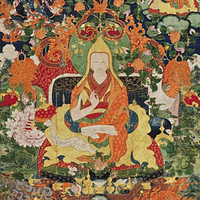
The Sixth Panchen Lama
The Sixth Panchen Lama, Losang Palden Yeshe (Blo-bzang dpal-ldan ye-shes, 1738-1780) holds a distinguished place in the annals of Tibetan Buddhism. His life was marked by significant religious, philosophical, and diplomatic achievements that had a lasting impact on the Gelug tradition and Tibet's relations with its neighbors, particularly with the Manchu Qing Dynasty of China. As Panchen Lama, he saw a blend of spiritual leadership and political acumen, reflecting the complex interplay between religious authority and worldly power in Tibetan society.
Born in the Tsang (gTsang) region of Central Tibet, he was recognized as the reincarnation of the Fifth Panchen Lama at a young age and was taken to Tashilhunpo Monastery (bKra-shis lhun-po) in Shigatse, the traditional seat of the Panchen Lamas. There, he received a traditional Tibetan education in Buddhist philosophy, meditation, and ritual, preparing him for his future roles.
As a spiritual leader, Losang Palden Yeshe played a pivotal role in the religious life of Tibet, initiating development projects at Tashilhunpo Monastery and promoting the study and practice of Buddhism across the region. Among his collected works, Answering Questions (Dri-len) clarified many points about anuttarayoga tantra and the Gelug/Kagyu tradition of mahamudra.
The Sixth Panchen Lama's diplomatic endeavors, particularly with the Qing Dynasty, underscore his importance in the geopolitical landscape of 18th-century Tibet and China. His visit to the Qing court in Beijing and interactions with the Qianlong Emperor highlight the cultural and religious exchanges between Tibet and China. The Qianlong Emperor regarded the Sixth Panchen Lama very highly, showing him the honor and bestowing on him the gifts normally reserved for the Dalai Lamas. As an indication of his high regard, he ordered the construction of the Xumi Fushou Temple, based on the design of Tashilhunpo, at his summer residence, Chengde.
Like many Tibetan leaders of his time, Losang Palden Yeshe was not without controversy. He was criticized by some Tibetan Buddhists precisely for the close relationship he had with the Manchu emperor mentioned above, as this was seen by many as a potential threat to Tibetan autonomy and culture. Some also criticized him for his efforts to modernize and develop Tibet, arguing that such efforts were at odds with traditional Buddhist values and practices.
It was during the above visit to China, in 1780, that Losang Palden Yeshe contracted smallpox and passed away. The subsequent response from both the Tibetans and the Qing court illustrates the high regard in which he was held. The Sixth Panchen Lama’s legacy is profound, influencing subsequent generations of Buddhists and the ongoing traditions of the Panchen Lama lineage and its connection with China.